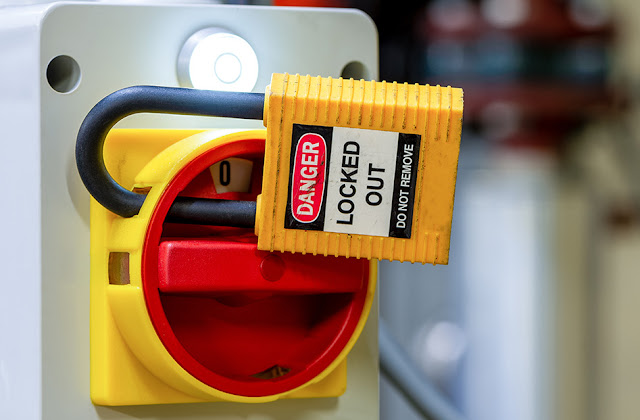The term "LOTO" stands for Lockout/Tagout, and it refers to a safety procedure used in workplaces to prevent the accidental start-up or release of energy from machinery and equipment during maintenance, servicing, or repair activities. The primary goal of the LOTO system is to protect workers from hazardous energy sources, such as electrical, mechanical, hydraulic, pneumatic, chemical, or thermal energy, which could cause serious injuries or fatalities if not properly controlled.
Lockout/Tagout (LOTO) system:
Purpose:
- The primary purpose of LOTO is to protect the safety of workers who are involved in maintenance or repair work on machinery and equipment.
- LOTO prevents the release of stored energy and the inadvertent operation of machines, which can cause injury or death.
- It ensures that equipment is safely de-energized, isolated, and locked or tagged to prevent unauthorized or accidental re-energization during maintenance tasks.
Key Elements of LOTO:
- Lockout:
This
involves physically locking the energy source controls in the off or
"safe" position. This might include using padlocks, disconnect
switches, or other locking devices.
- Tagout:
Tagout
complements lockout by using warning tags or labels that are affixed to the
locked-out equipment. These tags provide information about who performed the
lockout and why.
- Energy
Isolation: All energy sources (electrical, mechanical,
hydraulic, etc.) must be effectively isolated from the equipment. This
typically involves the use of valves, switches, or other mechanisms to cut off
the energy flow.
- Verification:
Before
maintenance begins, the person responsible for the LOTO process must verify
that all energy sources are properly isolated and that the equipment cannot be
started.
- Testing:
After
the LOTO procedure is completed and maintenance work is finished, equipment
must be tested to ensure it cannot be accidentally restarted.
LOTO Process:
- Preparation:
Identify
the equipment that needs maintenance, gather necessary tools, and inform
affected employees that a LOTO procedure will be performed.
- Shutdown:
Safely
shut down the equipment following standard operating procedures.
- Isolation:
Isolate
all energy sources to the equipment. This may involve turning off switches,
closing valves, or blocking mechanisms.
- Lockout/Tagout:
Physically
lock the energy isolation devices and attach warning tags to them. Each
employee involved in the process should use their personal lock and tag. Only
they should have the keys or authority to remove them.
- Verify:
Ensure
that the equipment is in a zero-energy state by attempting to start it. If it
doesn't start, the LOTO process is successful.
- Perform
Maintenance: The authorized employees can now safely perform
maintenance, repair, or servicing on the equipment.
- Restoration:
Once
the work is complete, remove the locks and tags. Re-energize the equipment
according to established procedures.
- Testing:
Test
the equipment to ensure it operates as expected.
- Communication:
Inform
all affected employees that the LOTO has been removed, and the equipment is
back in service.
Training and Procedures:
- Employees involved in the LOTO process must receive thorough training on the procedures, hazards, and proper use of lockout/tagout equipment.
- Employers are responsible for developing and maintaining LOTO programs and procedures specific to their workplace.
Regulatory Compliance:
LOTO procedures
are required by law in many countries and are often regulated by occupational
safety and health agencies to protect workers.
Benefits:
- Prevents workplace accidents and injuries.
- Ensures compliance with safety regulations.
- Protects employees during maintenance and repair work.
- Reduces the risk of equipment damage and downtime.
In
summary, the Lockout/Tagout (LOTO) system is a critical safety procedure in
workplaces where the unexpected release of energy from machinery and equipment
poses a danger to workers. Properly implemented LOTO procedures can save lives,
prevent injuries, and protect both employees and equipment.









